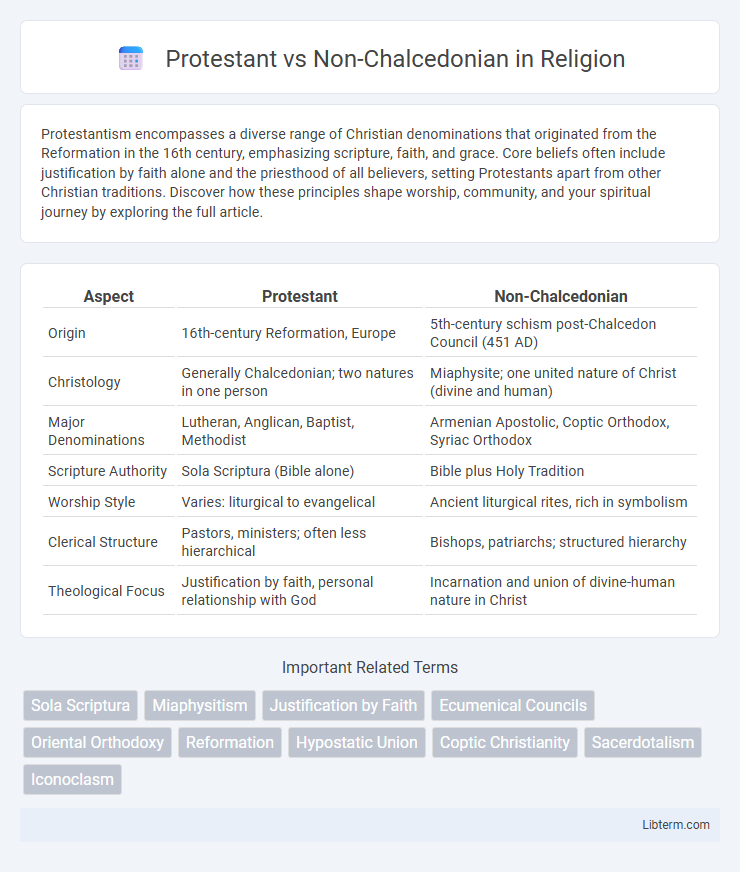Protestantism encompasses a diverse range of Christian denominations that originated from the Reformation in the 16th century, emphasizing scripture, faith, and grace. Core beliefs often include justification by faith alone and the priesthood of all believers, setting Protestants apart from other Christian traditions. Discover how these principles shape worship, community, and your spiritual journey by exploring the full article.
Table of Comparison
| Aspect | Protestant | Non-Chalcedonian |
|---|---|---|
| Origin | 16th-century Reformation, Europe | 5th-century schism post-Chalcedon Council (451 AD) |
| Christology | Generally Chalcedonian; two natures in one person | Miaphysite; one united nature of Christ (divine and human) |
| Major Denominations | Lutheran, Anglican, Baptist, Methodist | Armenian Apostolic, Coptic Orthodox, Syriac Orthodox |
| Scripture Authority | Sola Scriptura (Bible alone) | Bible plus Holy Tradition |
| Worship Style | Varies: liturgical to evangelical | Ancient liturgical rites, rich in symbolism |
| Clerical Structure | Pastors, ministers; often less hierarchical | Bishops, patriarchs; structured hierarchy |
| Theological Focus | Justification by faith, personal relationship with God | Incarnation and union of divine-human nature in Christ |
Historical Origins: Protestantism and Non-Chalcedonian Christianity
Protestantism originated in the 16th century during the Reformation, sparked by Martin Luther's critiques of the Catholic Church and emphasizing justification by faith and the authority of Scripture. Non-Chalcedonian Christianity, also known as Oriental Orthodoxy, traces its roots to the 5th century, rejecting the Council of Chalcedon's Christological definition and affirming a miaphysite understanding of Christ's nature. These divergent historical origins reflect fundamental theological disputes shaping their distinct doctrinal identities and ecclesiastical traditions.
Key Theological Differences
Protestant theology primarily emphasizes justification by faith alone, the authority of Scripture (sola scriptura), and the priesthood of all believers, diverging sharply from Non-Chalcedonian doctrine, which rejects the Chalcedonian Definition of Christ's two natures. Non-Chalcedonian churches, such as the Oriental Orthodox, affirm the miaphysite understanding that Christ has one united nature both human and divine, contrasting with Protestant dual-nature Christology rooted in Chalcedonian orthodoxy. This fundamental Christological difference impacts views on salvation, sacraments, and ecclesiastical authority, shaping distinct liturgical and doctrinal traditions within each tradition.
Understanding Christology: Chalcedonian vs Non-Chalcedonian Views
Protestant Christology aligns with Chalcedonian definitions, affirming Jesus Christ as fully divine and fully human in one person, based on the Council of Chalcedon's 451 AD doctrine. Non-Chalcedonian churches reject the Chalcedonian formula, emphasizing a miaphysite understanding where Christ's divine and human natures are united in one nature without separation. This fundamental theological difference shapes doctrinal interpretations of the incarnation, salvation, and the nature of Christ within Christian traditions.
Authority of Scripture and Tradition
Protestants emphasize the sole authority of Scripture (sola scriptura), rejecting traditions not explicitly grounded in the Bible, while Non-Chalcedonian churches uphold both Scripture and sacred Tradition as authoritative, maintaining apostolic teachings preserved through early church councils. Protestant theology prioritizes individual interpretation of the Bible guided by the Holy Spirit, contrasting with Non-Chalcedonian reliance on ecclesiastical tradition and patristic consensus for doctrinal guidance. These differing views on authority shape distinct approaches to theology, liturgy, and church governance between the two traditions.
Practices of Worship and Liturgy
Protestant worship emphasizes scripture reading, congregational singing of hymns, and sermon-centered services with minimal ritualistic elements, promoting simplicity and personal faith engagement. Non-Chalcedonian liturgies, such as those in the Coptic and Armenian churches, maintain ancient, highly structured rituals featuring incense, chanting, and Eucharistic prayers conducted in traditional languages to express continuity with early Christian traditions. The distinct liturgical frameworks reflect divergent theological emphases, where Protestants prioritize direct access to scripture and personal relationship with God, and Non-Chalcedonians preserve historic sacramental and liturgical forms rooted in monophysite Christology.
Structure and Leadership in Churches
Protestant churches typically feature a decentralized structure with various denominations led by councils, synods, or elected pastors, emphasizing congregational governance and autonomy. Non-Chalcedonian churches, including Oriental Orthodox traditions, maintain a hierarchical leadership system headed by patriarchs or catholicoi, preserving apostolic succession and centralized ecclesiastical authority. This distinction in governance reflects theological differences and historical developments impacting church administration and community organization.
Sacraments and Religious Rites
Protestant denominations generally recognize two primary sacraments: Baptism and the Eucharist, emphasizing symbolic interpretation and individual faith. Non-Chalcedonian churches, such as the Coptic and Armenian Apostolic Churches, maintain a broader sacramental system including Baptism, Chrismation, Eucharist, Confession, Matrimony, Holy Orders, and Unction, with a strong emphasis on mystical grace and apostolic tradition. The divergence in sacramental theology reflects deeper doctrinal differences, with Non-Chalcedonian rites preserving ancient liturgical practices contrasted by Protestant reformist simplifications.
Relationship with Other Christian Denominations
Protestant denominations generally emphasize biblical authority and often engage in ecumenical dialogues with other Christian groups, including Roman Catholics and Eastern Orthodox churches, fostering a collaborative approach despite doctrinal differences. Non-Chalcedonian churches, such as the Oriental Orthodox, maintain theological distinctions from Chalcedonian Christians, leading to limited communion but ongoing theological discussions aimed at mutual understanding and reconciliation. Both traditions contribute uniquely to the broader Christian mosaic, influencing interdenominational relationships through their distinct Christological perspectives and worship practices.
Major Branches and Demographics
Protestantism, a major branch of Christianity with over 900 million adherents worldwide, primarily includes denominations such as Lutheranism, Calvinism, Anglicanism, and Evangelicalism, flourishing mainly in North America, Europe, and Sub-Saharan Africa. Non-Chalcedonian Christianity, also known as Oriental Orthodoxy, comprises churches like the Coptic Orthodox, Armenian Apostolic, and Syriac Orthodox, collectively representing around 60 million believers concentrated in the Middle East, Northeast Africa, and parts of India. The demographic distribution of Protestants is significantly broader, with a pronounced presence in the Global South, whereas Non-Chalcedonian communities remain regionally concentrated with deep historical roots.
Contemporary Issues and Interfaith Dialogue
Protestant and Non-Chalcedonian Christian traditions face contemporary issues such as doctrinal differences and mutual recognition challenges that impact ecumenical relations. Interfaith dialogue efforts emphasize theological understanding and respect for divergent Christological interpretations to foster unity and cooperation. Ongoing discussions address social justice, religious freedom, and cultural pluralism, reflecting shared concerns amid doctrinal diversity.
Protestant Infographic

 libterm.com
libterm.com